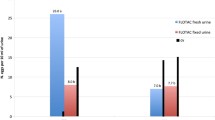Summary
The reliability of two methods for the detection of pyuria was studied in a total of 106 urine samples obtained from patients with identifiable underlying urinary tract disease. The coefficient of variation (CV) was significantly higher in the microscopic than in the counting chamber method. The CV obtained with the use of the KOVA slide 10 grid, a disposable and less expensive counting chamber, was identical to that obtained with the Bürker-Türk counting chamber. Only 50% of the patients who were proven to have pyuria of ≥ 5 WBCs/HPF by the microscopic method had significant bacteriuria of ≥ 104 bacteria per ml of urine. On the other hand, 95% and 90% of the patients who were proven to have pyuria of ≥ 10 WBCs/mm3 with the Bürker-Türk and Fuchs-Rosenthal counting chambers had significant bacteriuria. It was concluded that the counting chamber provides a reliable method for the detection of pyuria and is highly predictive for the presence of significant bacteriuria. The KOVA slide 10 grid is an acceptable alternative to the regular counting chamber.
Zusammenfassung
Die Zuverlässigkeit von zwei Pyurie-Nachweismethoden wurde in einem Kollektiv von 106 Urinproben geprüft, die von Patienten mit nachgewiesenen Erkrankungen des Harntraktes erhalten worden sind. Der Variationskoeffizienz (VK) war bei der mikroskopischen Methode signifikant höher als bei der Kammerzählmethode. Der VK war bei Verwendung des KOVA Objektträgers mit 10 Gittern, eine preiswerte Einmalzählkammer, identisch wie bei Verwendung der Bürker-Türk-Zählkammer. Nur 50% der Patienten, bei denen eine Pyurie von ≥ 5 Leukozyten (L) pro Gesichtsfeld (GF) × 400 mikroskopisch nachgewiesen worden waren, hatten eine signifikante Bakteriurie von ≥ 104 Bakterien pro ml Urin. Dagegen zeigten 95% bzw. 90% der Patienten, bei denen mit der Bürker-Türk- bzw. Fuchs-Rosenthal-Zählkammer eine Pyurie von ≥ 10 L/mm3 nachgewiesen worden waren, eine signifikante Bakteriurie. Die Zählkammermethode ist somit eine zuverlässige Methode zum Nachweis einer Pyurie und verfügt über einen hohen Vorhersagewert für eine signifikante Bakteriuric. Der KOVA-Objektträger mit 10 Gittern kann als Alternative zu der regulären Zählkammer akzeptiert werden.
Similar content being viewed by others
References
Rubin, R. H., Shapiro, E. D., Andriole, V. T., Davis, R. J., Stamm, W. E. Evaluation of new anti-infective drugs for the treatment of urinary tract infection. Clin. Infect. Dis. 15 (1992) S216-S227.
Kawada, Y. An outline of Japanese criteria for evaluating the clinical efficacy of antimicrobial agents in complicated urinary tract infections. In:Ohkoshi, M., Kawada, Y. (eds.): Clinical evaluation of drug efficacy in UTI. Excerpta Medica, Amsterdam 1990, pp. 37–48.
Rubin, R. H., Tolkoff-Rubin, N. E., Cotran, R. S. Urinary tract infection, pyelonephritis, and reflux nephropathy. In:Brenner, B. M., Rector, F. C., Jr. (eds.): The kidney. 4th ed. WB Saunders, Philadelphia 1991, pp. 369–429.
Stamm, W. E. Measurement of pyuria and its relation to bacteriuria. Am. J. Med. 75 (1987) 53–58.
Little, P. J. Urinary white-cell excretion. Lancet i (1962) 1149–1151.
Brumfitt, W., Davies, B. I., Rosser, E. Urethral catheter as a cause of urinary tract infection in pregnancy and puerperium. Lancet ii (1961) 1059.
Author information
Authors and Affiliations
Rights and permissions
About this article
Cite this article
Saito, A., Kawada, Y. Reliability of pyuria detection method. Infection 22 (Suppl 1), S36–S37 (1994). https://doi.org/10.1007/BF01716039
Issue Date:
DOI: https://doi.org/10.1007/BF01716039



